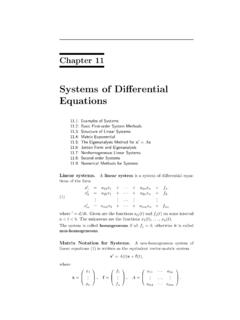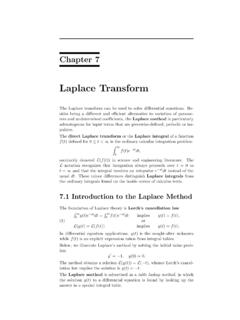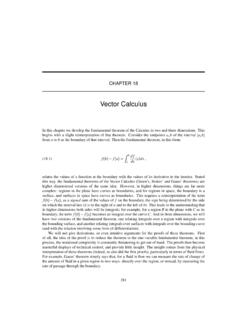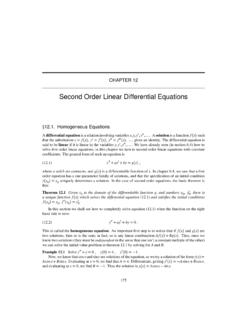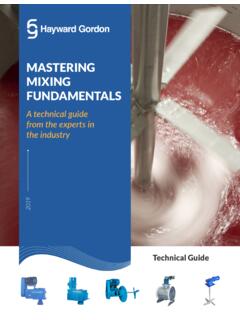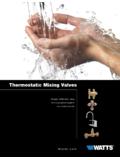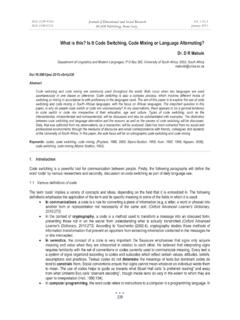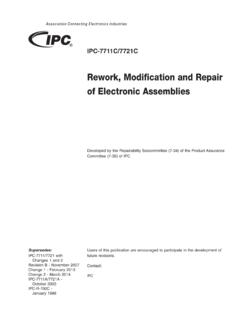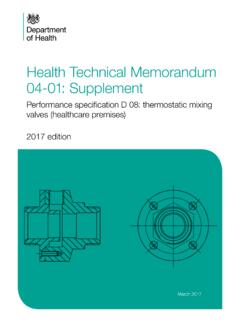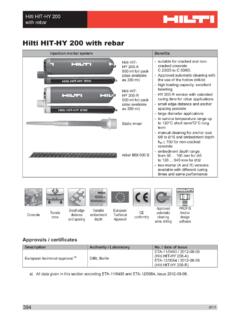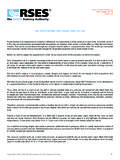Transcription of Systems of Differential Equations - University of Utah
1 Chapter 11 Systems of : Examples of : Basic First-order System : Structure of Linear : Matrix : The Eigenanalysis Method forx = : Jordan Form and : Nonhomogeneous Linear : Second-order : Numerical Methods for SystemsLinear systemis a system of differential equa-tions of the formx 1=a11x1+ +a1nxn+f1,x 2=a21x1+ +a2nxn+f2,..x m=am1x1+ +amnxn+fm,(1)where =d/dt. Given are the functionsaij(t) andfj(t) on some intervala < t < b. The unknowns are the functionsx1(t), .. ,xn(t).The system is calledhomogeneousif allfj= 0, otherwise it is Notation for non-homogeneous system oflinear Equations (1) is written as the equivalent vector-matrix systemx =A(t)x+f(t),wherex= ,f= , A= a11 ..am1 amn . Examples of Examples of SystemsBrine Tank 521 Cascades and Compartment 522 Recycled Brine Tank 523 Pond 524 Home 526 Chemostats and Microorganism 528 Irregular Heartbeats and 529 Nutrient Flow in an 530 Biomass 531 Pesticides in Soil and 532 Forecasting 533 Coupled Spring-Mass 535 Electrical Network 536 Electrical Network 537 Logging Timber by 538 Earthquake Effects on 539 Brine Tank CascadeLet brine tanksA,B,Cbe given of volumes 20, 40, 60, respectively, asin Figure 1.
2 Three brinetanks in is supposed that fluid enters tankAat rater, drains fromAtoBat rater, drains fromBtoCat rater, then drains from tankCatrater. Hence the volumes of the tanks remain constant. Letr= 10, toillustrate the stirring of each tank is assumed, which impliesuniform saltconcentrationthroughout each of Differential EquationsLetx1(t),x2(t),x3(t) denote the amount of salt at timetin each suppose added to tankAwater containing no salt. Therefore,the salt in all the tanks is eventually lost from the drains. The cascadeis modeled by thechemical balance lawrate of change = input rate output of the balance law, justified below incompartment analysis,results in the triangular differential systemx 1= 12x1,x 2=12x1 14x2,x 3=14x2 solution, to be justified later in this chapter, is given by the equationsx1(t) =x1(0)e t/2,x2(t) = 2x1(0)e t/2+ (x2(0) + 2x1(0))e t/4,x3(t) =32x1(0)e t/2 3(x2(0) + 2x1(0))e t/4+ (x3(0) 32x1(0) + 3(x2(0) + 2x1(0)))e and Compartment AnalysisAlinear cascadeis a diagram ofcompartmentsin which input andoutput rates have been assigned from one or more different compart-ments.
3 The diagram is a succinct way to summarize and document thevarious method ofcompartment analysistranslates the diagram into asystem of linear differential Equations . The method has beenused toderive applied models in diverse topics like ecology, chemistry, heatingand cooling, kinetics, mechanics and method. Refer to Figure 2. A compartment diagram consists ofthe following NamesEachcompartmentis labelled with a arrow is labelled with aflow RateAn arrowhead pointing at compartmentXdocu-mentsinput RateAn arrowhead pointing away from compartmentXdocumentsoutput Examples of Systems5230x3x2x1x3/6x2/4x1/2 Figure 2. Compartmentanalysis diagram represents theclassical brine tank problem ofFigure of the single linear differential equation for a diagram com-partmentXis done by writingdX/dtfor the left side of the differentialequation and then algebraically adding the input and outputrates to ob-tain the right side of the differential equation, according to thebalancelawdXdt= sum of input rates sum of output ratesBy convention, a compartment with no arriving arrowhead hasinputzero, and a compartment with no exiting arrowhead has the balance law to Figure 2 gives one differential equation foreach of the three compartmentsx1,x2, 1= 0 12x1,x 2=12x1 14x2,x 3=14x2 Brine Tank CascadeLet brine tanksA,B,Cbe given of volumes 60, 30, 60, respectively, asin Figure 3.
4 Three brine tanksin cascade with that fluid drains from tankAtoBat rater, drains from tankBtoCat rater, then drains from tankCtoAat rater. The tankvolumes remain constant due to constant recycling of fluid. For purposesof illustration, letr= stirring of each tank is assumed, which impliesuniform saltconcentrationthroughout each (t),x2(t),x3(t) denote the amount of salt at timetin each salt is lost from the system, due to recycling. Using compartment524 Systems of Differential Equationsanalysis, the recycled cascade is modeled by the non-triangular systemx 1= 16x1+16x3,x 2=16x1 13x2,x 3=13x2 solution is given by the equationsx1(t) =c1+ (c2 2c3)e t/3cos(t/6) + (2c2+c3)e t/3sin(t/6),x2(t) =12c1+ ( 2c2 c3)e t/3cos(t/6) + (c2 2c3)e t/3sin(t/6),x3(t) =c1+ (c2+ 3c3)e t/3cos(t/6) + ( 3c2+c3)e t/3sin(t/6).
5 At infinity,x1=x3=c1,x2=c1/2. The meaning is that the totalamount of salt is uniformly distributed in the tanks, in the ratio 2 : 1 : PollutionConsider three ponds connected by streams, as in Figure 4. The firstpond has a pollution source, which spreads via the connecting streamsto the other ponds. The plan is to determine the amount of pollutant ineach (t)Figure 4. Three ponds 1, 2, 3of volumesV1,V2,V3connectedby streams. The pollutionsourcef(t)is in pond the following. Symbolf(t) is the pollutant flow rate into pond 1 (lb/min). Symbolsf1,f2,f3denote the pollutant flow rates out of ponds 1,2, 3, respectively (gal/min). It is assumed that the pollutant iswell-mixed in each pond. The three ponds have volumesV1,V2,V3(gal), which remain con-stant. Symbolsx1(t),x2(t),x3(t) denote the amount (lbs) of pollutant inponds 1, 2, 3, Examples of Systems525 The pollutant flux is the flow rate times the pollutant concentration, ,pond 1 is emptied with fluxf1timesx1(t)/V1.
6 A compartment analysisis summarized in the following (t)f3x3/V3f2x2/V2 Figure 5. Pond compartment diagramrepresents the three-pondpollution problem of Figure diagram plus compartment analysis gives the following 1(t) =f3V3x3(t) f1V1x1(t) +f(t),x 2(t) =f1V1x1(t) f2V2x2(t),x 3(t) =f2V2x2(t) f3V3x3(t).For a specific numerical example, takefi/Vi= , 1 i 3, andletf(t) = lb/min for the first 48 hours (2880 minutes), thereafterf(t) = 0. We expect due to uniform mixing that after a long time therewill be ( )(2880) = 360 pounds of pollutant uniformly deposited,which is 120 pounds per ,x1(0) =x2(0) =x3(0) = 0, if the ponds were pristine. Thespecialized problem for the first 48 hours isx 1(t) = (t) (t) + ,x 2(t) = (t) (t),x 3(t) = (t) (t),x1(0) =x2(0) =x3(0) = solution to this system isx1(t) =e 3t2000 125 39sin 3t2000!
7 1253cos 3t2000!!+1253+t24,x2(t) = 250 39e 3t2000sin( 3t2000) +t24,x3(t) =e 3t2000 1253cos 3t2000!+125 39sin 3t2000!!+t24 48 hours elapse, the approximate pollutant amounts inpounds arex1(2880) = , x2(2880) = , x3(2880) = should be remarked that the system above is altered by replacing zero, in order to predict the state of the ponds after 48 hours. The526 Systems of Differential Equationscorresponding homogeneous system has an equilibrium solutionx1(t) =x2(t) =x3(t) = 120. This constant solution is the limit at infinity ofthe solution to the homogeneous system, using the initial valuesx1(0) ,x2(0) ,x3(0) HeatingConsider a typical home with attic, basement and insulated main 6. Typical homewith attic and below-grade basementand the attic are the main living area is usual to surround the main living area with insulation,but the atticarea has walls and ceiling without insulation.
8 The walls andfloor in thebasement are insulated by earth. The basement ceiling is insulated byair space in the joists, a layer of flooring on the main floor anda layerof drywall in the basement. We will analyze the changing temperaturesin the three levels using Newton s cooling law and the variablesz(t) = Temperature in the attic,y(t) = Temperature in the main living area,x(t) = Temperature in the basement,t= Time in data. Assume it is winter time and the outside temperaturein constantly 35 F during the day. Also assumed is a basement earthtemperature of 45 F. Initially, the heat is off for several days. The initialvalues at noon (t= 0) are thenx(0) = 45,y(0) =z(0) = heater. A small electric heater is turned on at noon, withthermostat set for 100 F. When the heater is running, it provides a 20 Frise per hour, therefore it takes some time to reach 100 F (probablynever!)
9 Newton s cooling lawTemperature rate = k(Temperature difference)will be applied to five boundary surfaces: (0) the basement walls andfloor, (1) the basement ceiling, (2) the main floor walls, (3) the Examples of Systems527floor ceiling, and (4) the attic walls and ceiling. Newton s cooling lawgives positive cooling constantsk0,k1,k2,k3,k4and the equationsx =k0(45 x) +k1(y x),y =k1(x y) +k2(35 y) +k3(z y) + 20,z =k3(y z) +k4(35 z).The insulation constants will be defined ask0= 1/2,k1= 1/2,k2= 1/4,k3= 1/4,k4= 1/2 to reflect insulation quality. The reciprocal 1/kis approximately the amount of time in hours required for 63%of thetemperature difference to be exchanged. For instance, 4 hours elapse forthe main floor. The model:x =12(45 x) +12(y x),y =12(x y) +14(35 y) +14(z y) + 20,z =14(y z) +12(35 z).
10 The homogeneous solution in vector form is given in terms of constantsa= (7 21)/8,b= (7 + 21)/8,c= 1 + 21,d= 1 21 andarbitrary constantsc1,c2,c3by the formula xh(t)yh(t)zh(t) =c1e t/2 122 +c2e at 4c2 +c3e bt 4d2 .A particular solution is an equilibrium solution xp(t)yp(t)zp(t) = 455827541854 .The homogeneous solution has limit zero at infinity, hence the temper-atures of the three spaces hover aroundx= 57,y= 69,z= 46 degreesFahrenheit. Specific information can be gathered by solvingforc1,c2,c3according to the initial datax(0) = 45,y(0) =z(0) = 35. The answersarec1= 8524, c2= 2524 115 21168, c3= 2524+115 heater. To the main floor each hour is added 20 F, butthe heat escapes at a substantial rate, so that after one houry 51 five hours,y 65 F. The heater in this example is so inadequatethat even after many hours, the main living area is still under 69 air furnace.
